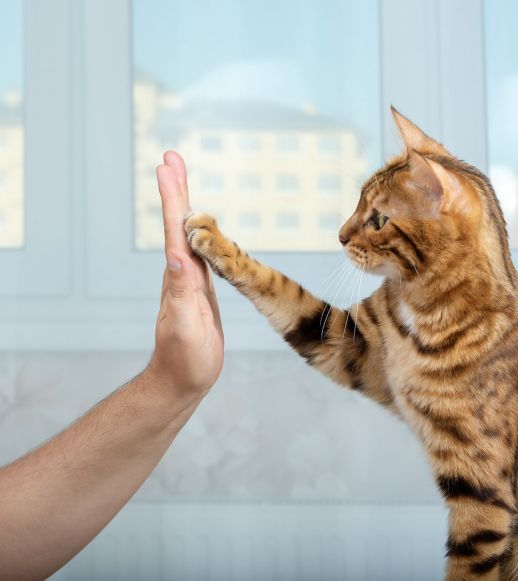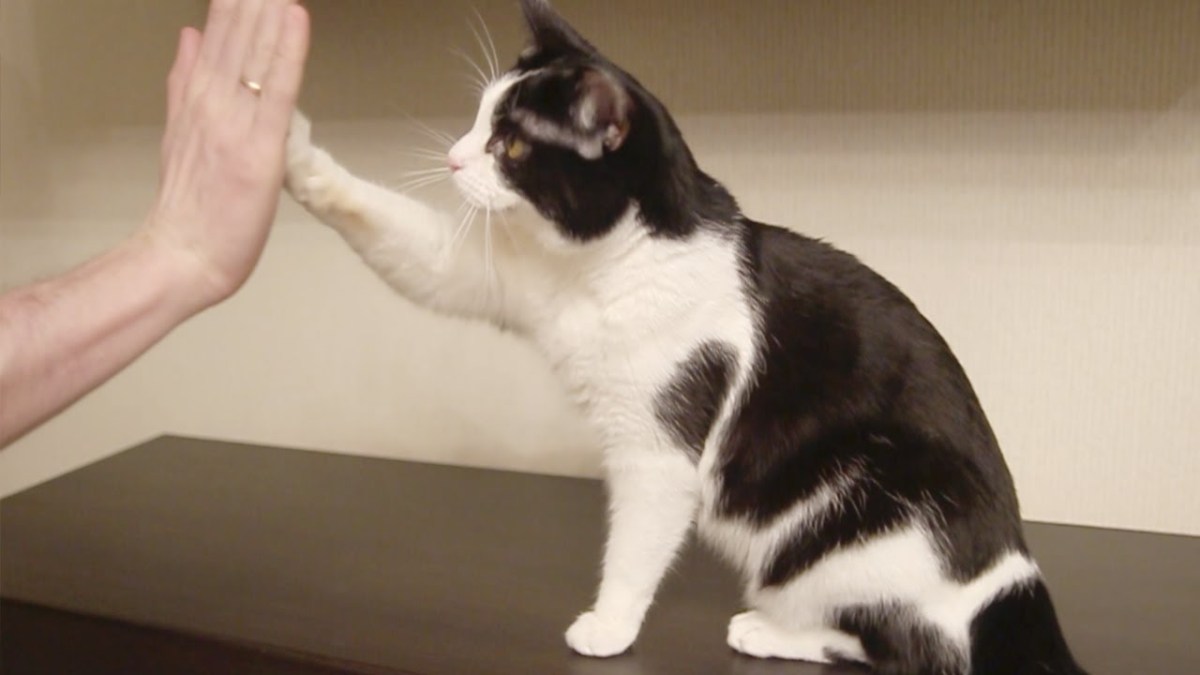My cousin thought I was joking when I told him my cat would come when called, sit when told and give me some love with a high five.
“Get outta here,” he said as we watched an NBA playoff game.
“Okay then,” I said. “Hey Bud!”
Buddy popped up from wherever he’d been lounging with a “Mrrrrrrrrppp!” He regarded me quizzically with his parakeet green eyes, knowing there was probably a treat in it for him as he padded toward me.
“Sit,” I said, gesturing for him to park his behind about two feet away from me. He sat.
“High five!” I said as Buddy leaned forward and slapped his paw against my palm.
I tossed him a treat for a job well done. If it were up to Bud, we’d high-five another 10 times.
There are a lot of misconceptions about cats, and one of them is the idea that felines aren’t amenable to training. It’s why people use the phrase “trying to herd cats” to describe an impossible task.
People don’t expect to see a cat complying, and they definitely don’t expect to see our feline friends pulling off tricks, which makes it more fun to defy expectations.
It’s easy to train your cat to pull off simple tricks — so easy that I almost couldn’t believe it when Bud was reliably high fiving me within a week.

Teaching a cat to sit is a prerequisite for high fives. It’s a straightforward and easy process.
After that, it’s really just a matter of building trust with your cat so she’ll allow you first to touch her paw, then to gently take it in your hand and raise it. The first few sessions, all you need to do is touch or hold your cat’s paw. On the second day, start to raise it slightly.
Cats don’t do well with long training sessions anyway, so the time commitment is minimal. One or two sessions a day, 10 to 15 minutes each.
Every time you touch kitty’s paw, bring it a little bit higher than the last time, rewarding your cat with encouragement and a treat. After a few sessions, your cat will anticipate this new ritual you’ve got going and will raise her paw as soon as you start.
The last step is holding kitty’s paw against your outstretched palm for just a second or two, then rewarding her with a treat.
That’s it. You’re done.
Run through the trick a few times a day after your cat’s got it down, to reinforce good high fiving form and whichever affirmations you choose. (I chose to say “Good boy!” each time Bud pulled it off rather than use a clicker.) Either method works, since the important things are consistency and positive reinforcement immediately after your cat does well. You want to make sure you click or say “Good boy!” right away so your cat knows the praise is triggered by a successful high five. (Or an intermediary paw raise if you’re still working on the trick.)
For a more detailed breakdown of how to do it, check out this video from CatManToo, a professional dog trainer who adjusted his methods for cats. This is the method I used to train Bud. Again, you don’t actually need a clicker, just a consistent method of feedback to signal that your cat is doing well:


I have been obedience-training my cats most of my life, and I’m 75.
As you say, consistency and praise is vitally necessary, but that is true for training dogs as well. Also, you are not supposed to train a puppy for more than 10 or 15 minutes at first, either.
I have some rules for my cats which are carved in stone: they must not get up on the kitchen table or counters. No fighting. They must not scratch the furniture; on the other hand, I provide plenty of places where they can meet their need to scratch.
Keeping it simple and consistent is the way to go.
By the way, I was given a puppy when I was around 9 years old, and my mother, who was very involved with obedience-training dogs, taught me how to train my puppy. She used a book called “Training You to Train Your Dog” (1950s variety) which emphasized that it was the owner who needed to learn the techniques of consistency, patience, and reward in order to be successful in training your pet.
LikeLiked by 1 person
I think it’s interesting that CatManToo (the author of the videos I linked in this post, which I also used to train Bud) is originally a dog trainer and applied his methods to cats. If you look up his Youtube channel, he’s got two cats he’s trained to ride skateboards and do all sorts of elaborate tricks.
The 1950s puppy book sounds like it gave the right advice.
FWIW Bud has never gone on the kitchen counters. Not once. The dinner table is a different story…
LikeLiked by 1 person
Yet, there’s a tragic human-nature propensity to perceive the value of life (sometimes even human life in regularly war-torn or overpopulated famine-stricken global regions) in relation to the conditions enjoyed or suffered by that life. With the mindset of feline disposability, it might be: ‘Oh, there’s a lot more whence they came’. Yet, these mammals’ qualities, especially their non-humanly innocence, make losing them such a great heart break for their owners.
Beautiful yet often misunderstood, prejudged and unjustly despised animals, cats are.
LikeLiked by 1 person
Tux would find this beneath him! He gets offended even when we try to get him to play with the wands or the ball toys! And catnip is not a draw for him!
LikeLiked by 2 people
He doesn’t respond to catnip at all? Have you tried catnip/silvervine blends or just silvervine by itself? I found a pretty big difference in response between the usual store-bought catnip and the silvervine mix stuff you can get online from Chewy.
As for training, you never know. Cats seem to really enjoy it, and they get a kick out of successfully high-fiving, not just for the treat. When I say “Good boy!” Buddy looks satisfied with himself, like “Yeah, I’m a good boy!”
LikeLiked by 1 person
Neat tutorial, I may just give this method a try. It’s interesting the cat favors a specific paw because the trainer offers his hand only on one side. Cats do have preferences, some of mine are left or right pawed. Could a cat be trained to use both paws to high five?
LikeLiked by 1 person
Yeah, you can train both, or have them switch off. It’s not so much which side the trainer offers a hand, since you can put your hand center in front of the cat. It’s a conscious decision to start with one paw in those early stages when you’re just getting the cat used to having his/her paw held for a few seconds and raised slightly.
LikeLiked by 1 person